A Nazi concentration camp commandant, Amon Goeth terrorized countless Jews — until he was executed for his crimes in 1946.

U.S. Army Archives/National ArchivesAmon Goeth was responsible for the deaths of an estimated 10,000 people during the Holocaust.
Before the release of Steven Spielberg’s 1993 film Schindler’s List, Amon Goeth’s name was relatively obscure, a small, reprehensible note in the annals of history. He might have been mostly forgotten, except by those who dug deep into the historical accounts of World War II.
Instead, Goeth has been forever cemented as Oskar Schindler’s adversary, thanks to Ralph Fiennes’ portrayal of Goeth in the film. And with this notoriety, the true horrors of Goeth’s crimes weren’t just brought to light but also carried into the realms of pop culture and movie history.
And although historical films often take creative liberties with their source material, little of Goeth’s character was exaggerated for the sake of drama. In fact, the real Goeth was even crueler than his movie counterpart.
Amon Goeth’s Rise Through The Nazi Ranks
Amon Leopold Goeth (sometimes spelled Amon Göth) was born on December 11, 1908, in Vienna, Austria. He was the only child of Berta Schwendt Goeth and Amon Franz Goeth, a Catholic couple who made a name for themselves in the publishing industry. And he attended public school in Vienna, but an academic career was not among Goeth’s ambitions.
As a teenager, he joined a youth chapter of the Austrian Nazi Party, and he became an official member in his early 20s. Per Britannica, he joined the Schutzstaffel (SS) in 1932. Since he had enlisted with the Nazis before Hitler’s rise to power, Goeth was considered an alter kämpfer, or “old fighter.”
While Amon Goeth was warmly received by his fellow Nazis, his many illegal activities with the party soon put him at risk for arrest in Austria, so he fled to Germany. He wouldn’t officially return to his home country until 1938 — when the Anschluss made Austria a part of the Third Reich.
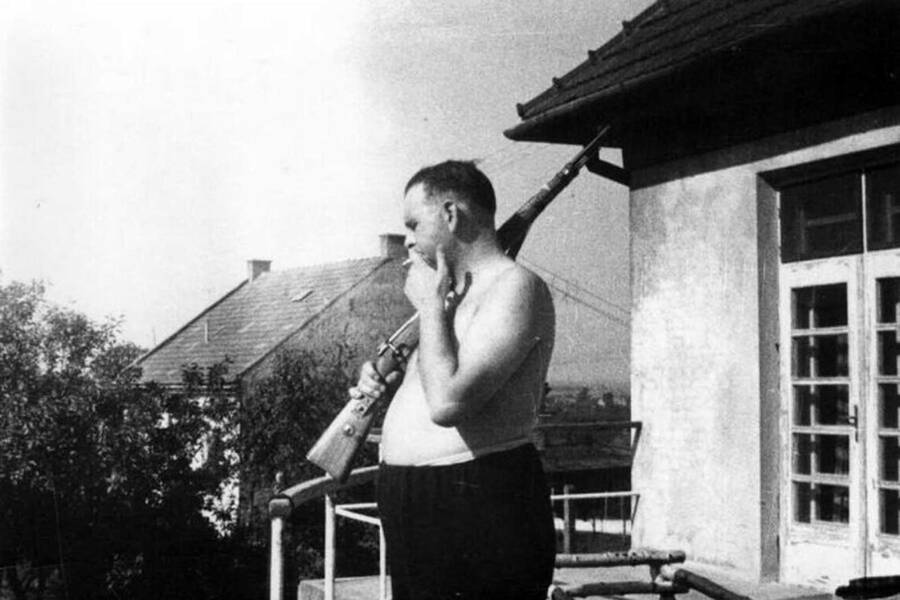
U.S. Army Archives/National ArchivesAmon Goeth overlooking the Kraków-Płaszów concentration camp in Nazi-occupied Poland from his villa balcony.
But even when Goeth was officially based in Germany, he still worked to smuggle weapons and information to Austrian Nazis. He also married his first wife, but the marriage was short-lived, and the divorce marked Goeth’s split from the Catholic Church. After officially returning to Vienna in 1938, Goeth entered his second marriage to a woman named Anna Geiger.
Back in his home country, Goeth quickly rose through the ranks of the SS, earning himself a promotion to the rank of untersturmführer (similar to a second lieutenant) in 1941. A year later, he joined Operation Reinhard, the Nazi scheme to murder Jewish people in German-occupied Poland.
Little is known of his activities during the operation, but Goeth clearly impressed his superiors. By 1943, he had been promoted to hauptsturmführer (similar to an army captain), and he had also become the commandant of the Kraków-Płaszów concentration camp.
It was there, at Płaszów, that Amon Goeth would commit the most heinous of his crimes — and meet his future adversary, Oskar Schindler.
Amon Goeth’s Cruelty At Płaszów — And His Relationship With Oskar Schindler
In addition to his role as commandant of the Płaszów camp, Amon Goeth was tasked with closing the nearby ghettos of Kraków and Tarnów, during which the seeds of his barbarism — and corruption — began to take root.
During the violent closings of these ghettos, the Nazis rounded up Jewish citizens and either killed them immediately or shipped them off to concentration camps, including Płaszów, if Goeth deemed them fit to work. According to Traces of War, Goeth personally murdered some of the Jewish victims himself, including up to 90 women and children in Tarnów alone.
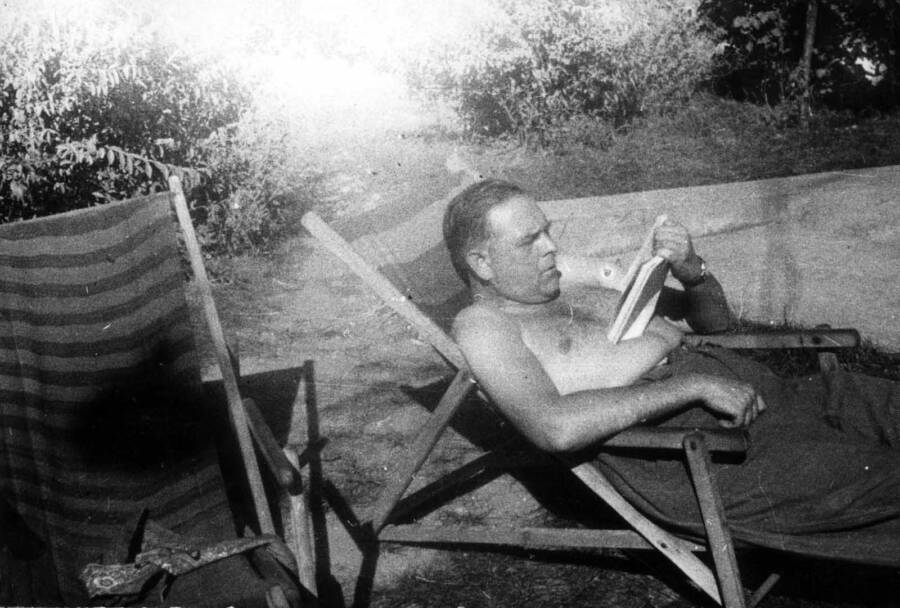
U.S. Army Archives/National ArchivesAmon Goeth lounging at his villa at the Kraków-Płaszów concentration camp.
He also began to steal personal items from the homes in the ghettos, taking clothing, jewelry, furniture, and other belongings, then selling them on the black market. Goeth made himself rich from this endeavor — and kept some of his favorite pieces of stolen loot to himself. But these goods that he hoarded and sold technically belonged to the Third Reich, not to Goeth personally. This would eventually come back to haunt him.
But for the time being, Goeth enjoyed the spoils of his position — and the power that came along with it. Goeth carried out executions at the Kraków-Płaszów concentration camp on an almost daily basis. Sometimes, he ordered his subordinates to kill prisoners, most of whom were Jewish. But other times, he would simply murder them himself.
There was no way for the prisoners to know when — or why — Goeth would carry out an execution. Camp survivors later reported that he killed prisoners for looking him in the eye, walking too slowly, and serving him soup that was too hot. Most of these victims were shot dead, as Goeth often used his rifle to kill people from the balcony of his villa at the camp.
However, some of Amon Goeth’s victims met a far more agonizing death, as he had trained his two dogs, Rolf and Ralf, to torture prisoners on command. And when Goeth began to suspect that the dogs were enjoying the company of their Jewish handler, Goeth reportedly had that handler killed as well.
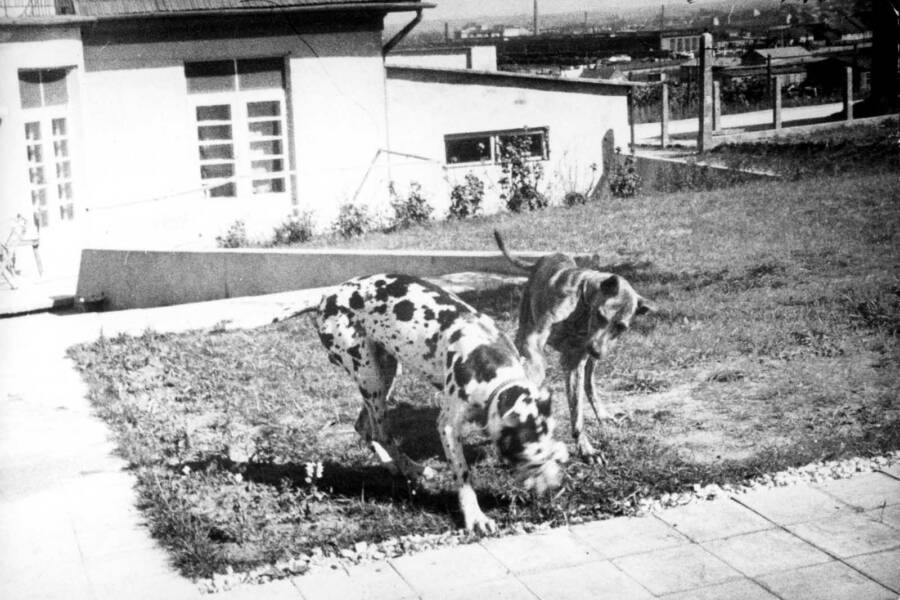
U.S. Army Archives/National ArchivesAmon Goeth’s dog Rolf (left), pictured with another dog.
Around this time, the German industrialist Oskar Schindler, who owned a nearby enamelware factory, discovered that Goeth had a weakness for flattery, luxurious gifts, and bribes. Though Schindler had been a member of the Nazi Party and had initially employed Jewish people at his factory so that he could pay them less than other workers and keep more money for himself, he had begun to hate everything that his party stood for.
So, the wealthy Schindler offered increasingly massive bribes to Goeth to ensure the protection and safety of his Jewish workers. In exchange, Goeth created separate barracks for Schindler’s employees, ensuring that they were spared from the cruelties of the Płaszów camp. (Schindler would later be credited with saving the lives of 1,200 Jews during the Holocaust.)
Despite their very different legacies, Goeth and Schindler had a number of things in common, including a Catholic background and an obsession with wealth, alcohol, and women. Both men also engaged in extramarital affairs. In Goeth’s case, the affair eventually led his second wife to divorce him. His mistress was a woman named Ruth Irene Kalder, an aspiring actress who happened to work as a secretary in Schindler’s factory.
Ultimately, Goeth’s loot-hoarding and bribe-accepting did not remain a secret from his superiors for long. In September 1944, he was arrested for corruption and brutality and held in Breslau for a month before he was transferred to Bad Tölz, Germany. It was there, in 1945, that he was arrested by U.S. troops. The restored Polish government later charged him with war crimes, including the killing of over 10,000 people during the Holocaust.
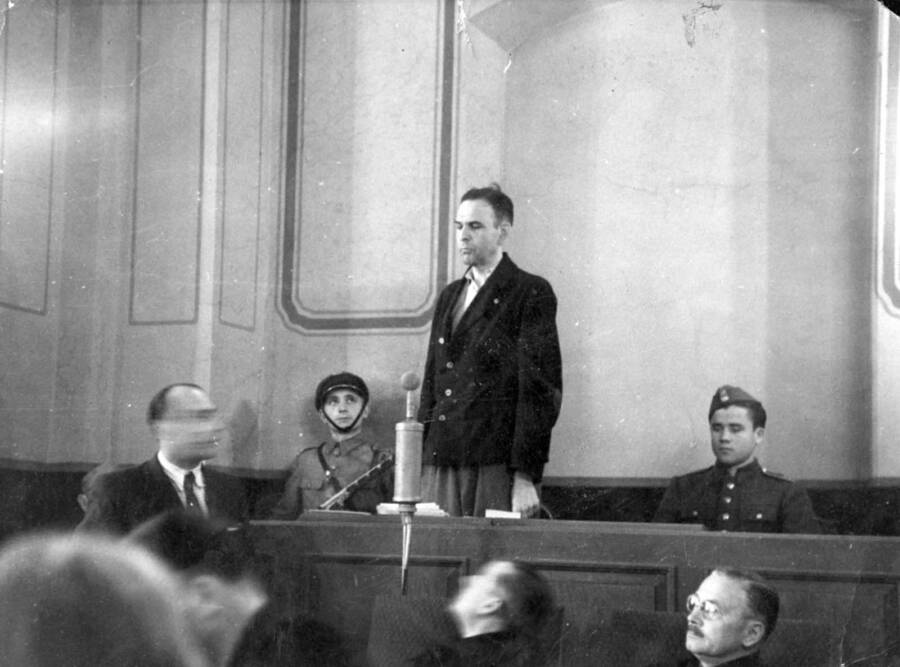
U.S. Army Archives/National ArchivesAmon Goeth during his trial, where he claimed that he was “only following orders.”
Amon Goeth was convicted of his crimes on September 5, 1946. Just days later, on September 13th, he was hanged. His final words were: “Heil Hitler.”
Typically, this is where Goeth’s story would end, but he was survived by a wife and two children — as well as his mistress’ daughter — and years later, one of Goeth’s grandchildren discovered the skeleton in her genetic closet.
“My Grandfather Would Have Shot Me”
Following Amon Goeth’s death in 1946, Ruth Irene Kalder was devastated. She had been in love with the commandant, despite his atrocities, and even took his last name when she learned that he had been hanged. But even before that, she had given birth to their daughter, Monika Hertwig, in 1945.
Years later, in 2002, Hertwig published a book titled I Do Have to Love My Father, Don’t I?, which detailed her life growing up with a mother who glorified Goeth. Hertwig later appeared in the 2006 documentary Inheritance and talked about coming to terms with her father’s horrific crimes.
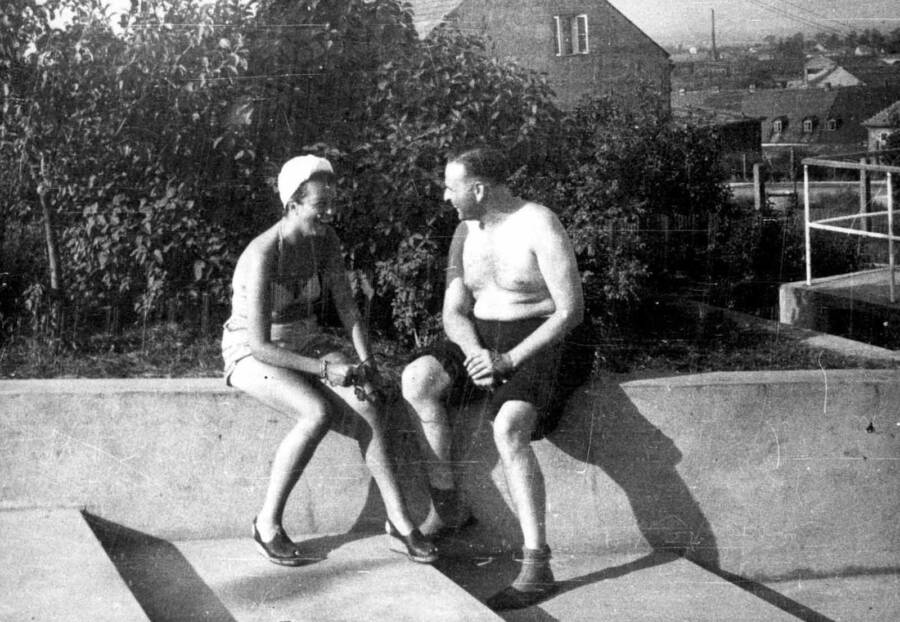
U.S. Army Archives/National ArchivesAmon Goeth pictured with his mistress, Ruth Irene Kalder.
Then, in 2008, a Black German woman named Jennifer Teege was in a library in Hamburg and stumbled across a copy of Hertwig’s memoir. As she flipped through the book, a shocking realization dawned upon her.
“At the end, the author summed up some details about the woman on the cover and her family, and I realised they were a perfect match with what I knew about my own biological family,” she wrote for the BBC. “So, at that point, I understood that this was a book about my family history.”
Teege barely knew her mother growing up, having been placed in a children’s home and then later adopted by a foster family, but she saw her a few times throughout her childhood until she was around seven years old. Her mother was Monika Hertwig, meaning that her grandfather was Amon Goeth.

Sven Hoppe/picture alliance via Getty ImagesJennifer Teege, the daughter of Monika Hertwig, the daughter of Amon Goeth and Ruth Irene Kalder.
“I slowly started to understand the impact of what I had read. Growing up as an adopted child, I did not know anything about my past, or only very, very little. Then to be confronted with information like this was so overwhelming,” she wrote. “It was weeks, a month, until I really started to recover.”
Eventually, Teege wrote a book of her own, titled My Grandfather Would Have Shot Me. As devastating as this revelation was for Teege, it also raised important questions about family, legacy, and what we choose to define us.
“I have tried not to leave the past behind but put it in a place where it belongs, which means not to ignore it, but not to let it overshadow my life,” Teege wrote. “I am not a reflection of this part of my family story, but I am still very connected to it. I try to find a way to integrate it into my life.”
After reading about Amon Goeth, go inside the macabre story of Josef Mengele, the Nazi “Angel of Death.” Or, learn about Adolf Hitler’s final days.





